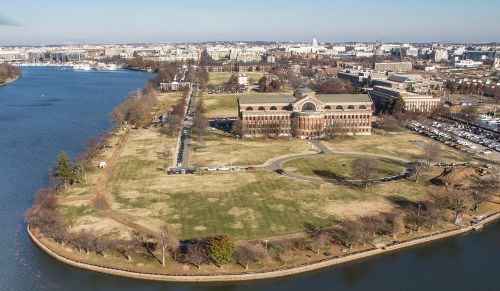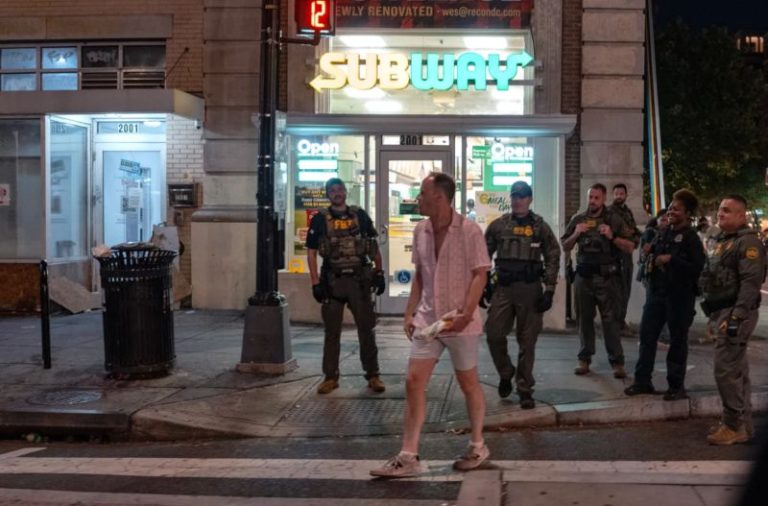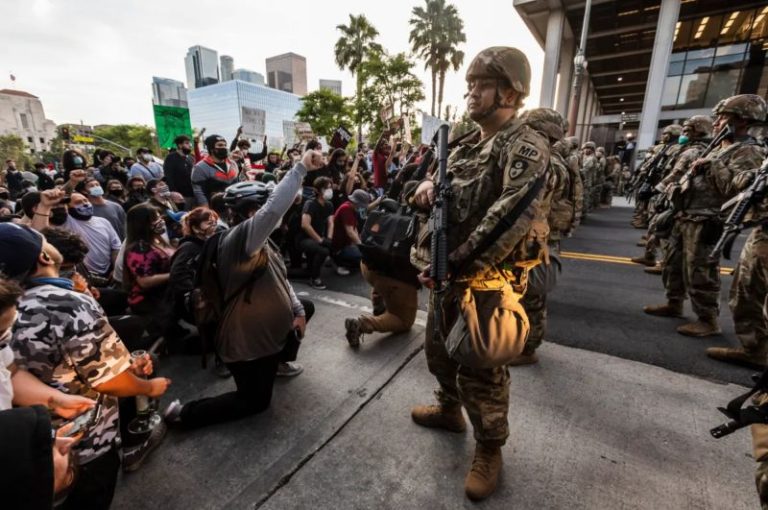

What is unfolding now is not yet tyranny, but it is the preparation for it. Power is being moved out of sight, into the hands of agencies and armed institutions less accountable to the public.

By Matthew A. McIntosh
Public Historian
Brewminate
Introduction
The signs of an authoritarian impulse rarely arrive as declarations. They appear instead in patterns: quiet, bureaucratic, and easily dismissed until the pattern becomes undeniable. Over the past several months, that pattern has begun to take shape across the machinery of the federal government. Immigration and Customs Enforcement has unlawfully detained not only undocumented migrants but also American citizens, often holding them for weeks or months with little transparency about where they are or why. At the same time, senior officials in President Donald Trump’s administration have begun relocating to military bases, citing vague concerns about “security” even as no credible threats have been identified.
Individually, each of these developments might seem explainable, even defensible, within the bounds of a volatile political moment. Together, they suggest something more deliberate: a quiet consolidation of power behind walls, wire, and armed guards. Trump has openly considered invoking the Insurrection Act, a 19th-century law granting broad domestic deployment authority to the military, and his officials’ movements hint at preparations for a government anticipating unrest of its own making.
What we are witnessing may not yet be the formal collapse of constitutional order, but it reflects a disturbing logic, one in which fear is both weapon and shield. The detentions, the relocations, the legal posturing all point toward a government increasingly willing to blur the line between national defense and domestic control. Before that line vanishes entirely, the public must confront what it means for a democracy when its leaders begin retreating behind the fortifications of the very military they command.
ICE Detentions of U.S. Citizens
The growing evidence that Immigration and Customs Enforcement (ICE) has detained American citizens reveals a fundamental breach of the Constitution’s most basic guarantees. More than 170 U.S. citizens have been wrongfully arrested or held in immigration custody in recent years, a number likely understated due to the agency’s own admission that it does not track such cases systematically. Many of those detained were denied access to counsel, held in remote facilities without contact with family, and in some instances transferred between centers until they effectively disappeared into the system.
These are not isolated bureaucratic mistakes. They expose the consequences of an enforcement culture where suspicion replaces evidence and where citizenship itself offers no assurance of protection. Civil liberties organizations have documented numerous instances in which U.S.-born individuals were detained or even deported. In one verified case, a Michigan-born Marine veteran was held for three days in an ICE facility despite presenting a valid birth certificate.
Senators Elizabeth Warren and Alex Padilla, joined by other members of Congress, have demanded investigations into these wrongful detentions, citing a “systemic disregard for due process” in a formal letter to the Department of Homeland Security. Yet the administration’s response has been limited, dismissing the incidents as anomalies rather than symptoms of a deeper problem.
The danger extends beyond those directly targeted. When citizens can be detained incommunicado under the machinery of immigration law, the boundaries between civil and military authority begin to erode. Immigration enforcement becomes a pretext for internal policing, one carried out not by accountable civilian institutions but by armed agencies operating with minimal oversight. In a government where fear is increasingly the organizing principle, the indefinite detention of citizens is not a glitch; it is a warning.
Senior Officials Moving Into Military Bases
In recent weeks, multiple credible reports have confirmed that a number of senior Trump administration officials have relocated to military installations, citing “security concerns” that remain largely undefined. At least six current or former Cabinet-level officials have taken up residence at or near military bases, including Joint Base Anacostia–Bolling and Fort Belvoir. Some are reportedly occupying quarters traditionally reserved for high-ranking officers and defense personnel.
The relocations have been confirmed by independent fact-checkers, which found verifiable instances of political appointees residing in secure military housing. Officials have publicly framed these moves as precautionary measures amid supposed threats to their safety, though the administration has not provided evidence of credible risks necessitating such steps. What makes this pattern notable is not the relocation itself, but the concentration of civilian political power within environments designed for military control.
In a democratic republic, the separation between civilian governance and military authority is not symbolic; it is foundational. By physically embedding civilian officials within the military’s infrastructure, the administration collapses a long-standing barrier intended to prevent the normalization of military involvement in political life. The optics alone should give pause: the nation’s executive leadership withdrawing from civilian spaces, surrounding itself with soldiers, and operating under the logic of security rather than accountability.
Historically, governments that begin retreating behind their own armed institutions are not merely protecting themselves; they are preparing for confrontation. Whether this relocation reflects fear, strategy, or a prelude to domestic enforcement, it represents a profound departure from norms that safeguard democratic transparency. The walls of a military base may offer safety, but they also conceal. And what begins as protection can easily become insulation from the people those officials were appointed to serve.
Threat of Military Involvement in Domestic Policing with the Insurrection Act
Trump’s public and private consideration of invoking the Insurrection Act has reignited fears of a creeping domestic militarization. The Insurrection Act of 1807 grants the president sweeping authority to deploy active-duty troops on U.S. soil under the pretext of restoring order, a measure historically reserved for rare, extraordinary crises such as the Civil War or desegregation conflicts in the 1960s. Yet Trump’s reported discussions, corroborated by sources within the administration, frame the act as a potential tool against perceived “internal threats,” a phrase so vague that it could encompass political dissent as easily as violence.
Recent reporting from NPR describes the administration’s growing reliance on National Guard units for mass immigration raids and deportations, a move critics argue edges perilously close to violating the Posse Comitatus Act, which restricts federal military involvement in civilian law enforcement. While administration officials claim these operations are necessary to maintain order during deportations, they also represent a blurring of military and police roles that democratic societies traditionally treat as distinct for good reason. Once troops are normalized in domestic enforcement, retraction of that power becomes politically, and psychologically, far more difficult.
Legal scholars and advocacy groups have voiced sharp concern. The president’s language surrounding “law and order” increasingly echoes past episodes where emergency powers became vehicles for suppressing opposition. Such fears are not unfounded: leaked drafts of contingency plans suggest that federal agencies have discussed how to synchronize military deployments with immigration sweeps and crowd control operations under the guise of “national stability.” Each proposal chips away at the firewall separating civilian governance from armed enforcement.
The administration’s defenders argue that the Insurrection Act is a lawful, constitutionally recognized mechanism for crisis response, and in a narrow sense, they are correct. But legality does not equal legitimacy. To invoke this power preemptively, or in response to political unrest rather than armed rebellion, would mark a historic rupture. The act’s language is so elastic that it can be weaponized to justify almost any domestic military action once a president deems an “insurrection” to exist. Such discretion, unchecked by Congress or the courts, undermines the very system of shared authority that defines republican government.
The threat, then, lies not only in what the administration might do, but in what it is teaching the country to accept. The public is being conditioned to see soldiers in the streets as normal, detention as necessary, and secrecy as security. Every normalization erodes a civic reflex, the expectation that power must answer to law, not to itself. Should the Insurrection Act ever be invoked for political control rather than genuine emergency, the legal precedent will outlive the moment. And history has shown that once a democracy crosses that line, it seldom retreats without consequence.
Convergence and Risk Assessment
The detentions, relocations, and militarization are not random or disconnected; they form a pattern of convergence that should alarm anyone who values civilian governance. Each action (ICE’s unlawful detentions of citizens, the relocation of senior officials to military bases, and the president’s flirtation with the Insurrection Act) represents a point on the same continuum: a government reorganizing itself around control, not accountability. The architecture of democracy is being subtly reengineered from within, shifting power away from transparent civilian institutions toward structures that operate behind security clearances and armed gates.
Historically, such convergence has preceded periods of domestic repression. The Posse Comitatus Act was written to prevent exactly this, the use of the military as an instrument of political enforcement. Yet when immigration agencies begin functioning as internal police, and political appointees live within bases surrounded by soldiers, the line between defense and domination becomes dangerously faint. The physical proximity of political power to military force has always been a predictor of authoritarian drift, whether in Latin America during the Cold War or in modern Hungary, where state security apparatuses were repurposed to suppress dissent under the guise of protecting national order.
The Trump administration’s moves also reveal a psychological shift: a government that no longer sees the public as a constituency to serve, but as a threat to manage. That shift transforms ordinary mechanisms of governance (enforcement, security, preparedness) into tools of containment. Once leaders view citizens as potential enemies, it becomes easy to justify extraordinary measures in the name of safety. In such an environment, democratic norms die not from coups but from compliance.
To be clear, some officials do face genuine security risks; political violence has become an undeniable feature of the modern era. But acknowledging those risks does not excuse the scale or symbolism of this relocation. When the halls of government empty into barracks, and federal power consolidates under military protection, even benign intent breeds dangerous precedent. It sends a message, that civil society is no longer safe enough for governance, and that power must withdraw from the people.
The real danger lies in habituation. Every “temporary” measure taken in fear becomes a model for future leaders eager to invoke the same powers. The more these actions are tolerated, the less extraordinary they seem, until a militarized state no longer feels like a crisis at all, just the way things are. That normalization is how democracies surrender without a single declaration, and how liberty fades not by force, but by familiarity.
Conclusion
What is unfolding now is not yet tyranny, but it is the preparation for it. The Trump administration’s pattern of wrongful detentions, retreat into military spaces, and flirtation with emergency powers represents a deliberate restructuring of how authority operates in the United States. Power is being moved out of sight, into the hands of agencies and armed institutions less accountable to the public. That alone is reason enough for alarm. The mechanisms of democracy can survive corruption and incompetence; they cannot survive concealment. Once power removes itself from the public sphere, it answers only to itself.
Congress must act decisively. Lawmakers should immediately open hearings into ICE’s detention practices and demand a transparent accounting of every U.S. citizen wrongfully held. They must also reassert civilian oversight of the military, ensuring that bases do not become safe havens for political appointees. Any consideration of invoking the Insurrection Act must trigger automatic congressional review before deployment. The rule of law depends on this shared authority, and if it collapses, it will not return easily.
Citizens, too, have a role that cannot be outsourced. A democracy endures only when its people refuse to be passive observers of its undoing. That means defending the principle that security cannot come at the cost of accountability, and that public office is not a private fortress. Silence in the face of creeping militarization is complicity, and the longer fear governs our responses, the weaker those responses become.
The United States has faced such tests before, moments when fear threatened to override freedom, and when demagogues cloaked power in the language of protection. Each time, recovery depended not on the benevolence of leaders but on the vigilance of the governed. The same is true now. Before the barbed wire closes around our own institutions, it must be confronted in full daylight. The task is not only to oppose an authoritarian future but to remember that such futures are built, piece by piece, from moments like this, when it was still possible to stop them.
Originally published by Brewminate, 11.11.2025, under the terms of a Creative Commons Attribution-NonCommercial-NoDerivatives 4.0 International license.


